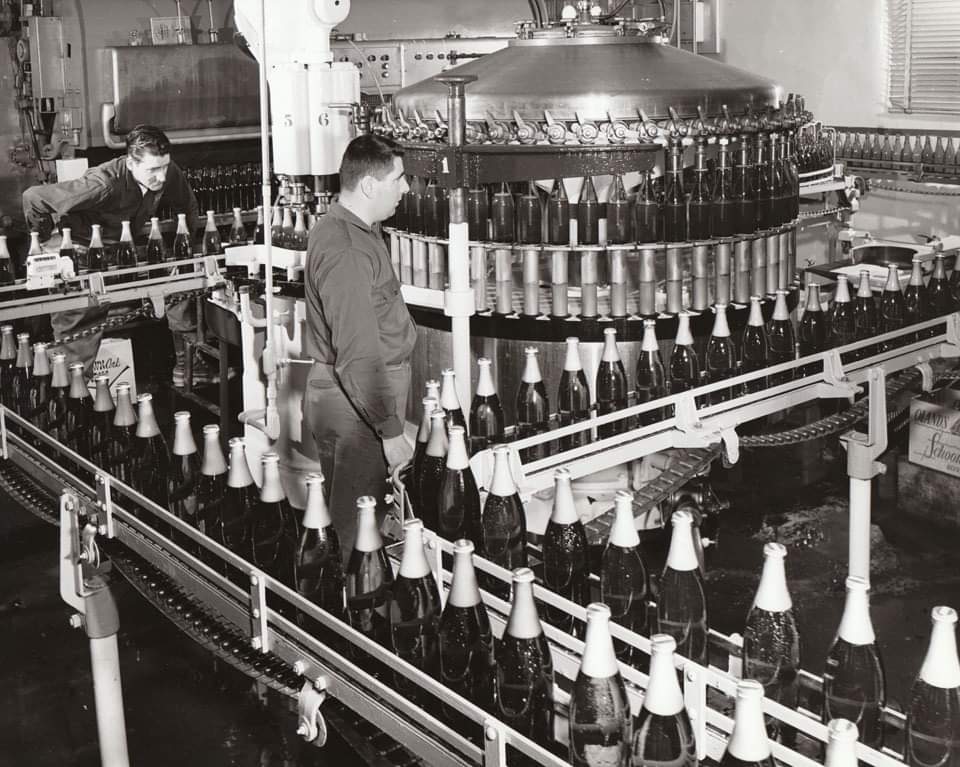This is the time of year when it all becomes a blur. Weekend plans for the next three months need to be scheduled because, before you know it, time times out and things gotta get done before the snow flies. Snow will fly. We know that. So I spent the past long weekend recreating my turf-bound ancestors life circa 1450. Fires and dirt and nothing much around to make a meal out of. Completely unlike the very modern lads of Halifax, Nova Scotia’s Oland brewery shown above circa 1950…or ’60… They are modernists. No safety glasses, no screens or other barriers as the clinky clacky glass flew by. “Lean in to check, Jerry!” the boss shouted. That being said I did, no doubt like the lads above, have a beer or two after my efforts were done.
Now, let’s see what’s gone on the world of brewing. I hope not as much as last week, given the news ran to almost 3000 words. First up, even though he is taking a break from his weekly round up, Stan is still producing his Hop Queries newsletter, now up to Vol. 6, No. 1., which included this passage on a product I have no personal interest in trying whatsoever – no alcohol, no calorie hop tea… or perhaps something even less:
I confess the word gimmick came to mind last month when the company announced the launch of Hoplark 0.0, Really Really Hoppy and invited me to see the plant. They are making the point that their drinks contain no alcohol and no calories. Because I’ve been buying their HopTea at my local grocery store, because hop water seems to have become a thing (there are other non-beer companies producing hop-flavored drinks, Lagunitas and Sierra Nevada have both launched national brands, and many smaller breweries have started to produce their own), and because Hoplark is being made only about a 30-minute drive from home I decided to visit.
Moving to matters of actual beery things, I liked this post at The Regency Town House website, an examination of urban planning circa 1825. It’s a discussion of the planning of Brunswick Street West in Brighton and Hove, England and the street is still there as is at least one of the pubs:
Busby’s scheme for Brunswick Town shows the east side of Brunswick Street West was planned to be individual stables and coach houses for the houses on the west side of Brunswick Square and the south spur of the road for stables at the rear of Brunswick Terrace West. The plan also shows the Star of Brunswick public house with a cottage opposite at the northern end of more stabling at the rear of the garden where Lansdowne Mansions would be built by the 1850s. There were two modest buildings just to the west of the pub which would be used as Green Grocers and Bootmakers.
The core of our fair city was build on Georgian plans and at work I regularly bump into stables and lanes for horses as part of the untangling of property interests. The air would be full of the scent of poo.
Knowing my family’s industrial Scottish reality, this discussion from the BBC is a very light touch on the devastating reality that organized intoxication was for most. Events from the 1890s still echoed into at least the 1960s as family members sought to escape their past and present.
Sticking with the 1800s, Edd Mather posted about brewings from August to December 1849 according to the Alexander Berwick & Co Brewhouse Book 1849 – 1852 which I understand was an Edinburgh outfit. Hefty brews from 6.3% to 8.7%. He then converted the first of the beers listed for home brewing set, in case you are interested in a pint of P3 come sometime in June.
Jubilee update. Coronation beers found in Stroud. Relatedly, someone felt “mildly patriotic” elsewhere.
Evan has a project on the go which all beer writers should be excited about, a survey of success and failures in book publishing. I added two sad tales but really need to balance off with the happier tales with Craig of Albany Ale… as well as Al and Max Theatre! Go make your confessions so that others may not suffer!
Eoghan wrote a strikingly sensible statement: “I will avoid subjecting you to my trite observations on my first experience of America…”
States in India have started rationing beer:
West Bengal recently began rationing beer to retail outlets with demand doubling over summer last year. Most states have witnessed volume recovery and are looking to surpass pre-pandemic levels, said Rishi Pardal, managing director of United Breweries, India’s largest beer maker. “Owing to peak summer demand, few states have also introduced local regulations have also introduced local regulations on movement of goods inter-state which may impact fulfilment of demand in certain markets,” Pardal said. “We are well-prepared to serve the market.”
On to the local election where all is quiet beer wise – odd given Canadian politicians tend to kiss more beer taps than babies during elections. One thing did happen. I was sent a copy of a lobbying document issued by the Ontario Craft Brewers but sent apparently by someone unhappy with the message. Here is the memo and here is a bit of the anonymous message in the covering email:
The attached may or may not come as news to you – but it would appear to be against your interests as contract brewing facilities, as well as anti-competitive and short sighted. The OCB appears to be focused on targeting and scapegoating smaller businesses, many of whom are diverse, incubators of new products, and if successful will eventually graduate to brick and mortar operations, while seemingly ignoring the much larger collective threat to Ontario Craft Beer from larger international brewers or the rapid growth of cocktails and ready to drink alcoholic beverages.
Heavens! Now, to be fair, the OCB memo does state that contract brewers do not contribute to local economies and take up valuable shelf space from those brewers who do. My immediate reaction was thinking of how these production breweries are often not “either or” businesses, how I knew of someone who worked a brewery’s canning machine who was packaging cases for plenty of other small breweries in Ontario, some bricks and mortar as well as some contractors. These smaller breweries and contracting firms would not otherwise would not have access to retail outlets or other expanded sales routes. And they, along with the production brewery itself, might not survive without this sort of work as part of the provincial supply chain. Many OCB members operate like this. Odd. The focus is needed elsewhere.
The gall is what gets you, as Afro.Beer.Chick flagged. So if someone wants to reference Juneteenth on a the label of some hazy IPA gak with fruit flavours added, does Mr. Driven Snow now get a chunk of change?
Bad behaviour claims against BrewDog continue – and I wonder if perhaps developing in a way that avoids the risk of examining similar acts closer to home. Are they the worst actor? Certainly not the sole bad actor. But the loss of reputation spreads. The situation is now tense. Evidence is undeniable. Individuals rightly utterly violated and repulsed. Me, I don’t drink the stuff myself. Good to see that the actual authorities with adjudicative powers are now becoming involved. Things need sorting.
And finally… Ron posted an excellent set of observations on another thing I avoid – beer fests – and how many are serving such small measures that they deserfve to be called “Thimble Fests“:
I used to go to many more. The main Belgian one, whatever that’s called now. The Borefts Festival. Others in Stockholm and Copenhagen. But that’s all a few years back. Now, I just can’t be bothered with most festivals. Why is that? Well, I’ve already told you, really. Lack of seating, long queues for beer. But the biggest reason of all is small measures. If you’re lucky, you might get a 15 cl serving. But it might well be just 10 cl or even a piddling 5 cl. I’ve got two glasses sometimes to take the edge off my frustration. Or taken along my own Imperial pint glass. A combination of small measures and long queues wring all the pleasure out of a festival for me. Getting in line for your next beer as soon as you’ve been served your last makes for a queueing festival rather than a beer festival.
Me, I don’t go as I don’t like being shedded with hundreds of drunk strangers. But I like that – “a queuing festival” pretty much sums that up.
There. Half the length and no doubt twice the value. For more, check out the updates from Boak and Bailey mostly every Saturday but not from Stan every Monday as he is on his summer holiday. Check out the weekly Beer Ladies Podcast, and at the weekly OCBG Podcast on Tuesday (Ed.: but not this week) and sometimes on a Friday posts at The Fizz as well. There is a monthly sort of round up at The Glass. (Ed.: that seems to be dead now.) There is more from DaftAboutCraft‘s podcast, too. And the Beervana podcast. And sign up for Katie’s irregular newsletter, The Gulp, too. And check out the Atlantic Canada Beer Blog‘s weekly roundup. Plus follow the venerable Full Pint podcast. And Fermentation Radio with Emma Inch. The AfroBeerChick podcast as well! And also look at Brewsround and Cabin Fever. And Ben has his own podcast, Beer and Badword (Ed.: …notice of revival of which has been given…) And remember BeerEdge, too, and The Moon Under Water. Things come. Things go.









